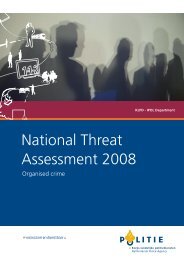Assessing the Effectiveness of Organized Crime Control Strategies ...
Assessing the Effectiveness of Organized Crime Control Strategies ...
Assessing the Effectiveness of Organized Crime Control Strategies ...
Create successful ePaper yourself
Turn your PDF publications into a flip-book with our unique Google optimized e-Paper software.
<strong>Assessing</strong> <strong>the</strong> <strong>Effectiveness</strong> <strong>of</strong> <strong>Organized</strong> <strong>Crime</strong> <strong>Control</strong> <strong>Strategies</strong>:<br />
A Review <strong>of</strong> <strong>the</strong> Literature<br />
currency and bearer instruments in excess <strong>of</strong> $10,000 into or out <strong>of</strong> <strong>the</strong> US (Abadinsky,<br />
2003:326). More than 12 million currency transaction reports are produced <strong>the</strong>re annually.<br />
Various US states also routinely analyze data obtained from currency transaction reports to<br />
identify both institutions and individuals involved in high volumes <strong>of</strong> cash transactions<br />
(Karchmer and Ruch, 1992:5). Such analyses are limited by <strong>the</strong> tendency <strong>of</strong> more sophisticated<br />
laundering schemes to conceal <strong>the</strong> ownership <strong>of</strong> funds, to break up large sums <strong>of</strong> money into lots<br />
<strong>of</strong> less than $10,000 (“smurfing”), or to circumvent <strong>the</strong> reporting <strong>of</strong> large transactions through<br />
<strong>the</strong> complicity <strong>of</strong> employees <strong>of</strong> financial institutions.<br />
The United States Treasury Department’s Financial <strong>Crime</strong>s Enforcement Network (FinCen)<br />
plays a key role in combating OC internationally, using anti-money laundering laws, providing<br />
intelligence, and case support to American and international investigators and regulators<br />
(Abadinsky, 2003). FinCen’s 200 employees include intelligence analysts and criminal<br />
investigators, as well as financial and computer specialists. It maintains a database that<br />
documents every suspicious-activity report since <strong>the</strong>y were initiated in 1996.<br />
Fur<strong>the</strong>rmore, under <strong>the</strong> Currency and Foreign Transactions Reporting Act, <strong>the</strong> United States can<br />
compel o<strong>the</strong>r countries to maintain financial records similar to those maintained in <strong>the</strong> US<br />
(Abadinsky, 2003:327). The financial institutions <strong>of</strong> countries that fail to establish an acceptable<br />
records system may be denied access to <strong>the</strong> US banking system. The implementation <strong>of</strong> this<br />
legislation is problematic as few countries require that financial institutions collect and report<br />
information on large or suspicious transactions (Abadinsky, 2003:328).<br />
It is hard to quantify <strong>the</strong> number <strong>of</strong> money launderers who are prevented from plying <strong>the</strong>ir trade<br />
in <strong>the</strong> US as a result <strong>of</strong> <strong>the</strong> reporting requirements. However, <strong>the</strong> information obtained as a<br />
result <strong>of</strong> US reporting requirements has been used extensively in regulatory, civil, and criminal<br />
investigations (Os<strong>of</strong>sky, 1993:364).<br />
The United States General Accounting Office has examined <strong>the</strong> enforcement <strong>of</strong> <strong>the</strong> Bank<br />
Secrecy Act <strong>of</strong> 1970, <strong>the</strong> legislation that required <strong>the</strong> reporting <strong>of</strong> transactions or transportation<br />
in or out <strong>of</strong> <strong>the</strong> US <strong>of</strong> large sums <strong>of</strong> currency. The GAO found that <strong>the</strong> US’ Treasury<br />
Department did not actively enforce <strong>the</strong> Act until 1985. The number <strong>of</strong> civil reviews for<br />
compliance increased to 76 in that year, most <strong>of</strong> which involved admissions <strong>of</strong> possible<br />
noncompliance by financial institutions (Albanese, 1996: 201). Civil penalties for just 11 <strong>of</strong> <strong>the</strong><br />
76 reviews totaled over $5 million. By 1990, <strong>the</strong> Internal Revenue Service’s Criminal<br />
Investigation Division had undertaken investigations resulting in over 1,000 convictions for<br />
<strong>of</strong>fences related to money laundering in just a three-year period (General Accounting Office,<br />
1991).<br />
Overall, <strong>the</strong> GAO evaluation found that <strong>the</strong> potential <strong>of</strong> <strong>the</strong> Bank Secrecy Act was not being<br />
realized. One problem is <strong>the</strong> sheer volume <strong>of</strong> currency transaction reports filed annually:<br />
currently, this volume is 12 million. The large volume <strong>of</strong> reports has made meaningful analysis<br />
difficult. Also, while an amendment to <strong>the</strong> Act made it illegal to undertake multiple transactions<br />
just under $10,000, <strong>the</strong> US Supreme Court ruled in 1994 that people could not be convicted for<br />
“smurfing” without pro<strong>of</strong> that <strong>the</strong>y knew such action to be illegal (Albanese, 1996:202).<br />
24 | Research and Statistics Division / Department <strong>of</strong> Justice Canada








